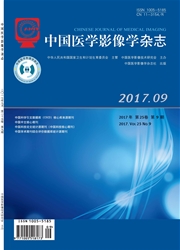

 中文摘要:
中文摘要:
目的 比较迭代模型重建(IMR)技术在不同辐射剂量条件下对肝脏CT增强扫描图像质量的影响,探讨IMR技术在不同辐射剂量条件下在肝脏CT增强扫描中的价值。资料与方法 54例行上腹部CT增强扫描患者,根据不同门静脉期扫描方案分为A组29例(120 kV,250 mAs)和B组25例(80 kV,500 mAs)。采用滤波反投影(FBP)重建技术和IMR技术重建门静脉期原始数据,得到4组图像,包括A1组(120 kV,FBP)、A2组(120 kV,IMR)、B1组(80 kV,FBP)和B2组(80 kV,IMR),比较各组图像质量客观评价指标图像噪声、图像信噪比(SNR)、对比噪声比(CNR)和主观评价指标低对比分辨率、图像失真及诊断信心度,并计算有效辐射剂量。结果 B组有效辐射剂量较A组降低42.7%(t=15.27,P〈0.001)。A2组图像噪声低于A1组,B2组图像噪声低于B1组,而B2组SNR及CNR较其他3组均显著增高(F噪声=81.98、FSNR=65.19、FCNR=37.42,P〈0.001)。各组低对比分辨率评分A2〉B2〉A1〉B1(χ2=58.21,P〈0.001),各组图像失真评分A1〉B1〉A2〉B2(χ2=12.94,P〈0.001),B2组与A1组、B1组间差异有统计学意义(P〈0.05);各组诊断信心评分A2〉A1〉B2〉B1(χ2=34.06,P〈0.001),A1组与B2组间差异无统计学意义(P〉0.05),其余组间差异有统计学意义(P〈0.05)。结论 与FBP比较,IMR技术不同辐射剂量扫描均可以降低肝脏CT增强扫描图像噪声并能提高图像质量,改变效果尤以80 kV、500 mAs CT扫描明显。
 英文摘要:
英文摘要:
Purpose To compare the image quality of contrast-enhanced hepatic CT using iterative reconstruction technique (IMR) at different radiation doses, and to explore the value of IMR in contrast-enhanced hepatic CT under different radiation doses. Materials and Methods Fifty-four cases undergoing contrast-enhanced hepatic CT were divided into two groups using different portal-venous phase protocols:29 cases in group A (120 kV, 250 mAs), 25 cases in group B (80 kV, 500 mAs). Portal venous phase CT images were reconstructed using IMR and filtered back projection to obtain 4 data sets:group A1 (120 kV, FBP), group A2 (120 kV, IMR), group B1 (80 kV, FBP) and group B2 (80 kV, IMR). Images were evaluated for noise, signal-to-noise ratio (SNR), contrast-to-noise ratio (CNR) as well as low contrast detectability (LCD), image distortion (ID) and diagnostic confidence (DC). Effective radiation dose was recorded. Results The effective radiation dose in group B was 42.7%, lower than that in group A (t=15.27, P〉0.001). Image noise in group A2 and B2 was significantly lower than that in group A1 and B1, with higher SNR and CNR (Fnoise=81.98, FSNR=65.19, FCNR=37.42, P〉0.001). There was significant statistical difference in LCD among four groups, A2〉B2〉A1〉B1 (χ2=58.21, P〉0.001), and in image distortion, A1〉B1〉A2〉B2 (χ2=12.94, P〉0.001). There was significant difference between B2 and A1, and between B2 and B1 (P〉0.05). For diagnostic confidence, the score was A2〉A1〉B2〉B1 (χ2=34.06, P〉0.001). There was no statistical significance between group A1 and group B2 (P〉0.05). Conclusion Compared with FBP, IMR technique can reduce image noise and improve image quality at low and high radiation doses, with better effect on low dose (80 kV, 500 mAs) hepatic CT.
 同期刊论文项目
同期刊论文项目
 同项目期刊论文
同项目期刊论文
 期刊信息
期刊信息
